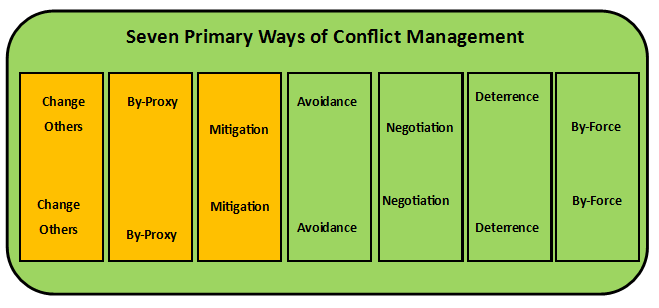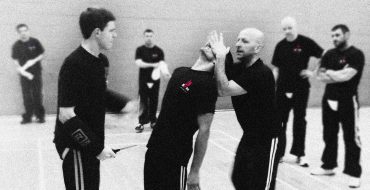Recap from Part I, Well, the reality is that you have been negligent in your considerations. You have not realised the stark differences between the environment in which you train and the environment outside. You finish training, pleased that you have just learnt a certain technique, strike, weapons defence, lock, choke, takedown, whatever it is, but then open the door and walk back onto the street to make your way home. Back to life and back to reality. Your Dojo is a cocoon of like-minded people who don’t want to hurt you (well, not too much) and will aid you, unknowingly most of the time, in helping you succeed. That is a great and wonderful thing of course, and something to be welcomed. I am proud of all of my students, the mutual respect they show for each other, the understanding, the stories, the insights, the questioning, the laughs, the fun – mostly the fun – but we never lose sight of the fact of why we train like we do and why we train at all.
So how can we identify flaws? Well here is something I work to that follows a basic scientific process of analysis and test.
1. Ask questions
2. Do your background research
3. Construct a hypothesis
4. Test (slow then fast under pressure, preferably not with someone who just yields because you are the Chief Instructor) and analyse your data
5. Draw your conclusions
6. Present your results
During my classes I am already at point 6. It is then open for my students to ask questions, do their own research and so on. If the defence technique works when performed slowly, then falls apart when practised fast, then you have identified a weakness and have something to work on.
I’ve found that much of what is taught, across the many disciplines I have either been involved in or studied and analysed, is not based on or even remotely looks like reality, rarely takes into account how people actually react, and is generally far too assumptive. Real fighting is messy, ugly, unrehearsed, aggressive, violent, usually bloody and let’s face it, quite abominable. Real fighting is all this and more. The flaw in all of our training is that none of it is real, but we can at least introduce some semblance of reality. Even in MMA, Boxing or Muay Thai, where an opponent can be struck with full force, there are still huge issues with those disciplines. For example, there are rules, a referee, time limits, people sitting at your corner waiting to help you recover each round, a towel can be thrown in the ring to stop the fight, doctors are on hand, plus as you enter the ring, you should already have an idea of what you are letting yourself in for. In addition, there is only one opponent not multiple, no weapons are carried nor are any laying around to be used. Biting, gouging, strikes to the throat or groin are not allowed. No hair pulling, no scratching, no kicks to the head are allowed when your opponent is on the floor etc etc. The list is quite long. Even during the 1920’s in the days of bare knuckle Vale Tudo (Portuguese for ‘anything goes’), you could kick and stomp to the head while standing above your opponent, but there was still the absence of weapons and multiple attackers. As harsh, hard, aggressive and violent as it was, it still had flaws in that it wasn’t ‘real’ in the context of this article. The thing is, it didn’t profess to be something it wasn’t and there is, of course, nothing wrong with that.
You can see, however, that the more you take steps to train without rules, the more effective your defence can become. Why do we not have kicks to the head on a grounded opponent in UFC? Why doesn’t MMA contain strikes like ploughing a knee square into the face of an opponent kneeling on the canvas? The answers are obvious, I would hope, but you can do that in real life if the threat is such that the level of force is proportionate and justified. I have personally trained with some very proficient Brazilian Ju-Jitsu and Mixed Martial Arts fighters and although they were more experienced in their field than me, I stopped my partners in their tracks when I applied an eye gouge, struck to the groin or applied some pressure on the windpipe with my elbow. This of course did not make me any better than them – far from it; these guys were very able in their art. It’s just that I was responding without the consideration of rules. I did what my survival default told me to do. If you apply rules, it isn’t reality training because there are no rules in a real fight. If your responses require fine motor skill applications, it isn’t reality training because things happen too fast for you to apply them; if you only ever train against one person, it isn’t reality training; if your training does not involve any form of pressure testing that is unscripted and non-choreographed, it isn’t reality training. There are many other aspects but you get the idea.
During my 18 years training and teaching Shotokan Karate, whenever I taught anything that remotely resembled a real attack, the defence fell apart. Students were lost when their practised defence failed. There was no contingency and no real mention of what happens if your first line of defence or counter strike fails. I understand that of course because again, it is a traditional Martial Art that is structured, generally follows a strict syllabus and is full of techniques that don’t work. It’s too scripted, too ‘clean’, too convoluted, and far too assumptive. Real fighting is none of those.
In 2006 I was invited to Japan to attend a Ju-Jitsu World Congress. Over 200 Students from around the world and a good number of very qualified instructors were all teaching their thing. What was noticeably constant was that for all demonstrations, opponents were compliant and it was all pretty much choreographed. Again I understand that. What was being taught was a traditional Martial Art. Yes, there were techniques that were applied with a certain level of force and yes, there were indeed some responses that could work. However, not once did I see anything that resembled a real attack. Students moved and responded in a certain way that would aid the defence response.
I’m aware that you are unable to attack 100% with full force. There are a finite number of students and your club would not last too long, but with padding and body protection the pressure could’ve been increased to get close to something a little more realistic. Fighting is far too dynamic and contains far too many variables to have the time to apply fine motor skills, flamboyant and over-technical responses, and, against a committed attacker, even a padded up one, it should highlight just how impractical a lot of these traditional defences are.
Hick’s law, named after British psychologist William Edmund Hick, describes the time it takes for a person to make a decision as a result of the possible choices he or she has: increasing the number of choices will increase the decision time logarithmically. So from a Self Protection angle, the more complicated the technique, the more choice we have in the syllabus, the longer it will take to process, and therefore the longer it will take to apply. During an attack, time is not on our side.
So, as I mentioned earlier, we have to understand and be clear on what we are learning. If we are being taught something that we are told is Self Protection and yet when put under pressure, the defence falls at the first hurdle, then it must be addressed. A student should be made aware from the outset if what they are learning, for example, is based on a traditional system. By that I mean they need to be aware if it has been handed down through the years and as a result would very likely have been changed and adapted, would usually contain certain techniques that may well have worked in feudal Japan, but is neither practical or workable for your average non-warrior in the street arena of today. It is important that the student is under no illusion.
Another way to identify flaws is to introduce elements of reality. It’s a simple task to get a well-trained student to perform a series of set techniques against an opponent who is attacking in a particular way. It will work fine. Transfer that same scenario to the street, mix it with a cocktail of adrenaline, non-adrenaline and endorphins, include a level of fear which you have never experienced or comprehended before that makes your legs turn to jelly, makes you want to vomit and empty your bowels and renders you incapable to talk or think straight, and you will discover that they are worlds apart. All of that without yet being hit, without seeing your own blood in your hands, without trying to make sense of what is going on, all without a real knife at your throat, or a firearm pointed at your head. A bit different, huh?
It would of course be ridiculous for me to suggest that I could even try to mirror this full-on street scenario during my classes, for obvious reasons, but what I can do is educate, analyse and develop. We can make our training honest and open to the fact that we can fail and mess up. If we don’t understand or even acknowledge where the weaknesses are in what we do, how can we possibly grow and progress in the right way? Nothing is set in stone and nor should it be.
I teach Krav Maga (Hebrew for Contact Combat), an Israeli system that, before its military links were established, was developed to help civilians defend themselves, irrespective of size or gender. By maintaining that ideal, it enables me to stress tactical and strategical implementation over technique. Whatever the defence is, it has to be able to work for anyone, and if what is being taught is based purely on technique alone, the result will be that it will work for some and not for others or may even fail completely. This is a major consideration when students are supposed to be learning something that should be protecting themselves, yet find they are one of the students the technique doesn’t work for!
So what can we do to overcome a technique only based system? I teach a three part strategy: disrupt the thought process of your attacker; unbalance your attacker; inflict damage/cause pain to your attacker. How you implement this strategy however, is not that important, but success in application will increase your chances of survival. The individual has to adapt to what he/she is presented with and, with so little time available to respond, the response should undoubtedly be quick, efficient, and take little thought process. When a technique fails, where do you go from there? If you have a plan and that fails, do you have a plan B or C? Do you have a contingency? If the strategy fails at any point, you can pick it up, overlap, and begin the strategy again, and again, and again. Implement an applicable strategical process and you will be able to continuously adapt to the stimulus.
It is important to remember that if something is principally sound and taught to students in their thousands, it does not by any means make it flawless, honest or real. Indeed the automatic acceptance of something that is taught that way because “just look at the pedigree, it must be correct” is rarely if at all questioned. It is also important to be aware that there are many that look to feed the money machine, fill the pockets of those at the top, exploit the naive and uneducated, and serve to set the pedestal of the untouchable instructor even higher.
Whatever it is we are learning or teaching, we must operate within the realms of reality and seek the truth. With something that is as important as surviving a life threatening attack, the analytical breakdown and defence responses should be commensurate. What we should be left with is something that is honest, practical and workable. Reality and life should not be different because they are one and the same. Life is our reality, and if what we are learning does not reflect this, then we need to question ourselves and what we do before it’s too late.






